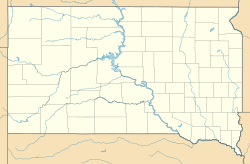John and Kate Merkwan Rubblestone House-Barn facts for kids
Quick facts for kids |
|
|
John and Kate Merkwan Rubblestone House-Barn
|
|
| Location | Eastern side of Highway 25, Tabor, South Dakota |
|---|---|
| Architectural style | Czech folk architecture |
| NRHP reference No. | 87001040 |
| Added to NRHP | July 6, 1987 |
The John and Kate Merkwan Rubblestone House-Barn is a special old building in Tabor, South Dakota, United States. It's called a "house-barn" because it was built to be both a home for people and a barn for animals or storage.
This unique building was constructed around the year 1900. It was added to the National Register of Historic Places on July 6, 1987. This happened because it's a great example of "Czech Folk Architecture" from southeastern South Dakota.
Contents
What is a Rubblestone House-Barn?
A "house-barn" is a building where a family could live in one part, and the other part was used as a barn. This was a common way to build homes in some parts of the world, especially for farmers. It helped keep people and animals close, which was useful during cold winters.
Built with Rubblestone
The Merkwan House-Barn is made from "rubblestone." This means it was built using stones that were not perfectly shaped. Builders used stones of different sizes and shapes, fitting them together like a puzzle. This style of building was strong and used materials that were easy to find nearby.
Why Combine a House and Barn?
Combining a house and a barn into one building had many benefits. It saved on building materials and labor. It also made it easier for farmers to care for their animals, especially in bad weather. The warmth from the animals could even help heat the living areas.
A Piece of Czech History
The John and Kate Merkwan Rubblestone House-Barn is important because it shows the building style of Czech immigrants. Many Czech families moved to South Dakota in the late 1800s and early 1900s. They brought their traditions and building methods with them.
Czech Folk Architecture
"Czech folk architecture" refers to the traditional ways Czech people built their homes and farms. These buildings often used local materials and designs that had been passed down through generations. The Merkwan House-Barn is a great example of how these traditions were used in America. It helps us understand the lives of these early settlers.
Why is it a Historic Place?
The John and Kate Merkwan Rubblestone House-Barn is listed on the National Register of Historic Places. This is an official list kept by the United States government. It includes buildings, sites, and objects that are important in American history, architecture, archaeology, engineering, or culture.
What Does "Historic" Mean?
When a building is "historic," it means it tells a story about the past. It helps us learn about how people lived, worked, and built things a long time ago. Protecting these places helps future generations understand their history.
Part of a Special Study
This house-barn was added to the National Register as part of a larger study. This study looked at many buildings that showed "Czech Folk Architecture of Southeastern South Dakota." This means experts recognized that these buildings were special and needed to be preserved.
Where is Tabor, South Dakota?
Tabor is a small town in southeastern South Dakota. It is located in Bon Homme County. This area has a rich history of settlement by people from different European countries, including many Czech immigrants. The town and its surrounding areas still show signs of this heritage.



